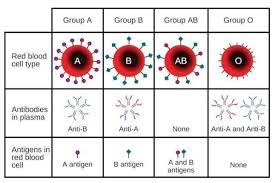Introduction to Blood Components and Grouping - ABO and RH Systems Explained
Blood is a specialised connective tissue that circulates throughout the body, transporting oxygen, nutrients, hormones, and waste products. In a healthy individual, about 5 litres of blood flows through blood vessels, maintaining vital functions. The major components of blood include red blood cells (RBCs or erythrocytes), white blood cells (leukocytes), platelets (thrombocytes), and plasma.
Every person’s blood contains specific antigens on the surface of their red blood cells and antibodies in the plasma. These antigens and antibodies form the basis for different ABO blood group system classifications and the Rh system. This classification is crucial for blood transfusion and understanding blood groups and their characteristics.
ABO Blood Group System
The ABO system was discovered by Karl Landsteiner in 1900, for which he later received the Nobel Prize. He observed that mixing blood from different individuals could lead to clumping (agglutination), caused by the interaction of antigens on red blood cells with antibodies in the plasma.

The ABO group is determined by the presence or absence of two key antigens on the surface of RBCs, called antigen A and antigen B:
Group A: Has antigen A on RBCs and antibody B in plasma.
Group B: Has antigen B on RBCs and antibody A in plasma.
Group AB: Has both antigens A and B on RBCs, and no anti-A or anti-B antibodies in plasma.
Group O: Has no antigens (neither A nor B) on RBCs but both anti-A and anti-B antibodies in plasma.
The ABO system is vital when administering blood transfusions. A mismatch can result in red blood cells clumping, leading to serious complications. Here is a quick compatibility guide:
Group A: Can receive blood from A and O groups.
Group B: Can receive blood from B and O groups.
Group AB: Can receive blood from A, B, AB, and O groups (universal recipient).
Group O: Can donate blood to all other ABO groups (universal donor), but can only receive from O.
Rh Blood Group System
In addition to ABO grouping, the Rh system plays a major role in determining if a person’s blood is Rh-positive (Rh⁺) or Rh-negative (Rh⁻). The key antigen in the Rh system is the D antigen.
Rh-positive (Rh⁺): RBCs have the Rh (D) antigen on the surface.
Rh-negative (Rh⁻): RBCs do not have the Rh (D) antigen, but the plasma may develop Rh antibodies upon exposure to Rh-positive blood.
An Rh⁻ individual receiving blood from an Rh⁺ donor (or vice versa) can develop immune reactions if not managed properly. This is especially significant in pregnancy, where an Rh⁻ mother carrying an Rh⁺ foetus may develop antibodies against the foetal RBCs.
Significance of Blood Grouping
Safe Blood Transfusion: Matching ABO and Rh blood groups prevents harmful transfusion reactions.
Organ Transplantation: Correct blood group compatibility reduces rejection risks.
Maternal-Foetal Health: Monitoring Rh compatibility is crucial during pregnancy.
Unique Blood Group Facts
Most Common Blood Type: In many populations worldwide, O positive blood type is considered the most common blood type.
Rarest Blood Type: Commonly, AB negative is cited as the rarest blood type among the ABO-Rh combinations. However, there is also a rare phenotype called the Bombay phenotype (hh), which lacks the precursor antigen for A and B, making it extremely rare in certain parts of the world.
Which is the Strongest Blood Group? There is no official “strongest” group. However, O negative is often called the universal donor because it can be donated to nearly all ABO-Rh groups.
A Positive Blood Type: This is also fairly common in many populations, making it compatible with A positive and AB positive recipients.
Quick Quiz on Blood Groups
Question: Which scientist discovered the ABO blood group system?
Answer: Karl LandsteinerQuestion: Which blood group is known as the universal donor?
Answer: Group O negativeQuestion: Which blood group is known as the universal recipient?
Answer: Group AB positiveQuestion: Which is often cited as the rarest blood type in the ABO-Rh system?
Answer: AB negativeQuestion: Name one important antigen in the Rh system apart from D.
Answer: The C or E antigen
Related Topic Links


FAQs on Blood Groups (ABO & RH): Types, Characteristics & Importance
1. Can a person’s blood group change over time?
Typically, blood groups remain the same throughout a person’s life. However, in very rare cases (such as bone marrow transplants or certain diseases), minor changes may occur.
2. Why is it essential to test for both ABO and Rh groups before a transfusion?
ABO and Rh incompatibility can cause the recipient’s immune system to attack the donor’s red blood cells, leading to serious reactions.
3. Can Rh-negative individuals receive Rh-positive blood?
In emergency cases, medical teams are cautious. Rh-negative individuals may form antibodies if exposed to Rh-positive blood, which can cause complications in subsequent transfusions or pregnancies.
4. How is the Bombay phenotype different from regular blood types?
The Bombay phenotype (hh) lacks the H antigen necessary for A or B antigens to be expressed, making standard tests often label it as O. However, individuals with this phenotype cannot receive regular O blood, as they still produce antibodies against the H antigen.
5. What happens if a pregnant woman is Rh-negative and the baby is Rh-positive?
The mother’s body can produce antibodies against the Rh-positive red blood cells of the foetus. To prevent complications, mothers are given an Rh immunoglobulin injection (Anti-D) as advised by doctors.










